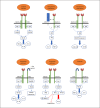Antifungal Innate Immunity: A Perspective from the Last 10 Years
- PMID: 29768268
- PMCID: PMC6784043
- DOI: 10.1159/000488539
Antifungal Innate Immunity: A Perspective from the Last 10 Years
Abstract
Fungal pathogens can rarely cause diseases in immunocompetent individuals. However, commensal and normally nonpathogenic environmental fungi can cause life-threatening infections in immunocompromised individuals. Over the last few decades, there has been a huge increase in the incidence of invasive opportunistic fungal infections along with a worrying increase in antifungal drug resistance. As a consequence, research focused on understanding the molecular and cellular basis of antifungal immunity has expanded tremendously in the last few years. This review will provide an overview of the most exciting recent advances in innate antifungal immunity, discoveries that are helping to pave the way for the development of new strategies that are desperately needed to combat these devastating diseases.
Keywords: Antifungal immunity; Fungal pathogens; Pathogenesis.
© 2018 The Author(s) Published by S. Karger AG, Basel.
Figures



References
-
- Brown GD. Dectin-1: a signalling non-TLR pattern-recognition receptor. Nat Rev Immunol. 2006;6:33–43. - PubMed
-
- van den Berg LM, Zijlstra-Willems EM, Richters CD, Ulrich MM, Geijtenbeek TB. Dectin-1 activation induces proliferation and migration of human keratinocytes enhancing wound re-epithelialization. Cell Immunol. 2014;289:49–54. - PubMed
-
- Olynych TJ, Jakeman DL, Marshall JS. Fungal zymosan induces leukotriene production by human mast cells through a dectin-1-dependent mechanism. J Allergy Clin Immunol. 2006;118:837–843. - PubMed
-
- Cohen-Kedar S, Baram L, Elad H, Brazowski E, Guzner-Gur H, Dotan I. Human intestinal epithelial cells respond to β-glucans via dectin-1 and Syk. Eur J Immunol. 2014;44:3729–3740. - PubMed
-
- Gross O, Gewies A, Finger K, Schafer M, Sparwasser T, Peschel C, Forster I, Ruland J. Card9 controls a non-TLR signalling pathway for innate anti-fungal immunity. Nature. 2006;442:651–656. - PubMed
Publication types
MeSH terms
Substances
Grants and funding
LinkOut - more resources
Full Text Sources
Other Literature Sources
Medical
Research Materials

